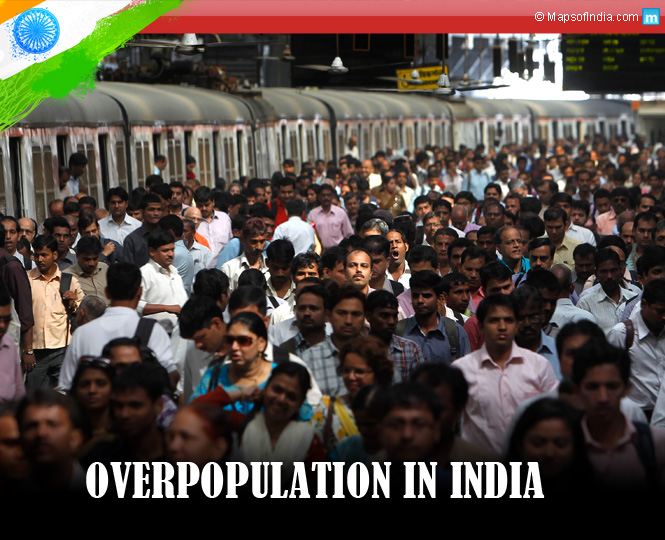Every nook and corner of India is a clear display of the increasing population.
Whether you are in a metro station, airport, railway station, road, highway, bus stop, hospital, shopping mall, market, temple, or even in a social/ religious gathering, we see all these places are overcrowded at any time of the day. This is a clear indication of overpopulation in the country.
According to the Indian census, carried out in 2011, the population of India was exactly 1,210,193,422, which means India has crossed the 1-billion mark. This is the second most populous country of the world after China and the various studies have projected that India will be world’s number-1 populous country, surpassing China, by 2025. In spite of the fact that the population policies, family planning and welfare programmes undertaken by the Govt. of India have led to a continuous decrease in the fertility rate, yet the actual stabilisation of population can take place only by 2050.
Why India Needs Population Control Bill
The two main causes leading to over population in India are:
- The birth rate is still higher than the death rate. We have been successful in declining the death rates but the same cannot be said for birth rates.
- The fertility rate due to the population policies and other measures has been falling but even then it is much higher compared to other countries.
The above causes are interrelated to the various social issues in our country which are leading to over population.
- Early Marriage and Universal Marriage System: Even though legally the marriageable age of a girl is 18 years, the concept of early marriage still prevails in many sections of the society and getting married at a young age prolongs the childbearing age. Also, in India, marriage is a sacred obligation and a universal practice, where almost every woman is married at the reproductive age.
- Poverty and Illiteracy: Another factor for the rapid growth of population is poverty. Impoverished families have this notion that more the number of members in the family, more will be the numbers to earn income. Some feel that more children are needed to look after them in their old age. Also, hunger can be a cause of death of their children and hence the need for more children. Strange but true, Indians still lag behind when it comes to the use of contraceptives and birth control methods. Many of them are not willing to discuss or are totally unaware of them. Illiteracy is thus another cause of over population
- Age-old cultural norm: Sons are the bread earners of the families in India. This age-old thought puts considerable pressure on the parents to have children until a male child is born.
- Illegal migration: Last but not the least, we cannot ignore the fact that illegal migration is continuously taking place from Bangladesh, Nepal and Myanmar is adding to increased population density.
Effects of Over Population
Even after 75 years of independence, the structure of our country is not stable, due to over population. Some major impacts of the high population are as follows:
- Unemployment: Generating employment for a huge population in a country like India is very difficult. The number of illiterate persons increases every year. The unemployment rate is thus showing an increasing trend. Adding to these vows was the COVID-19 pandemic which pushed millions on to the brink of poverty and unemployment.
- Manpower utilisation: The number of jobless individuals is on the rise in India due to economic depression, slow business development and expansion activities.
- Pressure on infrastructure: Development of infrastructural facilities is unfortunately not keeping pace with the growth of population. The result is lack of transportation, communication, housing, education, healthcare etc. There has been an increase in the number of slums, overcrowded houses, traffic congestion etc.
- Resource utilisation: Land areas, water resources, forests are over exploited. The growing population could pose a threat to already existing ecosystem, as the number increases consumption increases which puts stress on natural resources which could lead to shortage of water and food.
- Decreased production and increased costs: Food production and distribution have not been able to catch up with the increasing population and hence the costs of production have increased. Inflation is the major consequence of over population.
- Inequitable income distribution: In the face of an increasing population, there is an unequal distribution of income and inequalities within the country widen. Due to excessive number of individuals, the job is not valued appropriately which could significantly bring down the value of the skill.
Steps to Control Population in India
The Government of India, policy-makers should initiate a bold population policy so that the economic growth of the country can keep pace with the demands of a growing population. Major steps which have been already implemented but still need to be emphasised more control population. A few steps that need to be taken in order to bring population under control:
- Increasing welfare and status of women- In many section of our society, women are still treated as second-class citizens. They are not allowed to pursue education and hence spend their life doing household work. However, instead of confining women to house duties and letting them study can prove to be beneficial as it could add to growing status of the women plus an additional source of income.
- Spreading of education– Illiteracy is one of the key reason as mentioned above, the government is taking numerous step for both adult and children to pursue their education for free from government institution, this can lead to exceptional growth in country’s literacy rate and inspire more individuals to come forward to learn and understand the consequences of Over population.
- Increasing awareness for the use of contraceptives- Talking about contraceptives is still Taboo in various parts of our society. There should be camps that need to organized to make men and women aware about contraceptives.
- Family planning- Family planning is one of another few steps helping towards controlling population. Good family planning can bring stability to an individuals life.
- Encouraging male sterilization- Sterlization is extremely effective way of controlling birth control and one can engage with their partners without worrying.
- Free distribution of contraceptives and condoms among the poor- Due to hesitation among the poor regarding contraceptives. The government and Hospitals should come together to organize camps to distribute as well as make people aware about contraceptives and their benefits.
- Increase the number health care centres for the poor- The Government should also focus on increasing free health care centres, so that individuals can get themselves tested and sterilized if needed.
India’s strengths in the global world in various fields cannot be ignored, whether in science & technology, medicine and health care, business and industry, military, communication, entertainment, literature and many more. Experts are hopeful that by increasing public awareness and enlisting strict population control norms by the Government will definitely lead the way for the country’s economic prosperity and control of the population.
Related Information:
Expanding middle class in India





